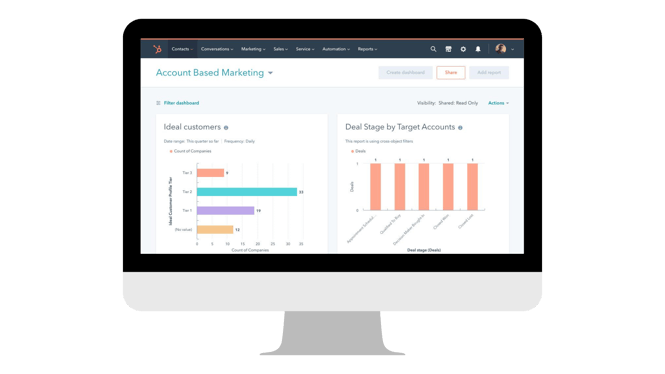Account-based marketing (ABM) is an important B2B focused-growth strategy used within sales and marketing teams to market to specific accounts for individual organizations. Unlike inbound marketing, which casts a wide net in hopes that a qualified buyer will land on your website, ABM is a targeted, precision approach.
Using an ABM strategy works extremely well in finite markets where you can identify a group of companies that are a good fit to purchase your products or services. One example is targeting drilling services within the oil and gas sector. It’s easy to determine from publicly available reports every E&P company that is currently drilling a well. Further delineation through filters such as job title, location, and company size will help you determine who at an E&P you can market to through ABM.
Before tracking the results of an ABM campaign, you need to know which metrics are most effective in measuring your campaign performance and success. These four metrics help measure and understand your ABM campaign’s performance, setting you up for marketing success.
Understanding the Importance of Metrics in ABM
Because the B2B sales cycle can be painfully long, your sales team risks spending too much time chasing leads that don’t turn into sales opportunities. ABM thrives on accurate engagement metrics by using actionable data to ensure your sales team only works the leads that are most likely to convert.
Metrics provide tangible information and insights to enable sales and marketing teams to understand the impact of their targeted efforts. While traditional inbound marketing typically utilizes broader metrics for a generalized audience, ABM metrics take a personalized approach to collect key insights on specific accounts, allowing for data-driven decisions to optimize campaign performance and results.
The Role of ABM Metrics for Industrial Companies
ABM metrics play a key role in industries like oil and gas, petrochemical, manufacturing, and other industrial sectors because of the high value and somewhat lengthy sales cycles present in these industries. For industrial companies falling within these sectors, ABM metrics serve some of the following purposes:
- Enhanced account engagement to assess how target accounts respond to marketing efforts
- Improved ROI with higher conversion rates and improved deal velocity
- Stronger brand awareness and authority through personalized content
- Greater visibility to help your company stand out in highly competitive markets
The Importance of HubSpot and ABM
HubSpot offers built-in features to simplify the ABM process, such as Target Accounts, Ideal Customer Profile Tiers, properties for buying roles, and a Sequences tool to send automated sales emails. HubSpot and ABM work hand-in-hand to help you create an effective ABM strategy and achieve campaign success. HubSpot’s ABM tools help sales teams effectively track, analyze, and leverage key metrics throughout the entire campaign process. 
ABM Metric 1: Coverage
Coverage is a key metric to measure in ABM strategies. This metric helps determine how complete your account data is and whether you have the right target accounts in your database. It effectively tracks your data quality and the comprehensiveness of your insights, informing your overall strategy.
You can measure and analyze coverage data using HubSpot’s target account tracking. Accurate ABM tracking in HubSpot requires you to define your target accounts and create lists or workflows specific to each account. This process helps you determine things such as:
- Have you identified all the target accounts and segmented them by tier?
- Do you understand all buying roles within your target accounts?
- How many accounts already have account-specific content and where are the content gaps that you need to fill?
- What are the restrictions and limiters for each account that can be tightened or relaxed based on campaign success?
- Have you determined the outreach sequence for each group of buyers and the engagement metrics that define a qualified lead?
ABM Metric 2: Engagement
Keeping your customers engaged with your content is important for an ABM campaign’s success and for developing future strategies. Engagement measures how involved your customers are with your content and is commonly used to determine the effectiveness of a marketing campaign. HubSpot offers various techniques to track and increase engagement with the platform, including the following:
- Track topics your target audience is interested in to encourage higher conversion rates on ABM campaigns. Information on these topics will ensure your messages are relevant to the recipient, encouraging readers to become promoters.
- Analyze the type of marketing content your audience prefers and track preferences over time to keep engagement rates consistent and deliver media in a format that your audience is receptive to.
- Maintain tabs on prior engagement frequency to identify your most engaged accounts and remain engaged with your top accounts.
ABM Metric 3: Impact on Sales Pipeline
According to a report by Alterra Group, 97% of marketers who have implemented an ABM strategy achieve a higher ROI than if they only used traditional marketing tactics such as inbound marketing. It is undeniable that ABM’s influence on generating qualified leads and building a healthy sales pipeline is huge.
Your team can use HubSpot to measure ABM’s influence on your sales pipeline in the following ways:
- Define your target accounts and ideal customer tiers.
- Set up deal stages and track deal progression through a dedicated target account pipeline or by using deal tags.
- Track deal velocity by measuring the time between stages and time to close.
- Measure average deal amount and compare it to deals generated by traditional methods.
- Build an ABM-specific dashboard to track conversions and analyze ABM-generated leads.
ABM Metric 4: Revenue Influence

The revenue influence metric covers the overall impact and total revenue gained from deals that the ABM campaign touches. Marketing and sales activities are considered interconnected in ABM revenue influence, and their alignment significantly enhances the contribution.
You can track and maximize revenue influence using HubSpot in the following ways:
- Have clear revenue goals and expectations.
- Track your sales pipeline development and movement.
- Use closed-loop reporting and attribution models to measure and track the source of deal origination.
- Automate marketing tasks to complement sales activities.
- Develop and monitor sales and marketing alignment.
Mastering ABM Strategy with HubSpot: Highway 9 Consulting’s Blueprint for Success
Measuring ABM campaign success requires careful attention to metrics like coverage, engagement, impact on sales pipeline, deal velocity, and revenue influence. Sales and marketing teams can utilize these metrics alongside HubSpot to maximize the impact of their ABM campaigns.
Whether you’re looking to refine your current ABM strategy or start fresh, Highway 9 Consulting is your partner in success. With our comprehensive understanding of ABM, these important metrics, and the power of HubSpot, we’ll help you optimize your campaigns and reach your marketing goals. Contact us today to unlock the full potential of your account-based efforts through Highway 9 Consulting’s ABM services.


